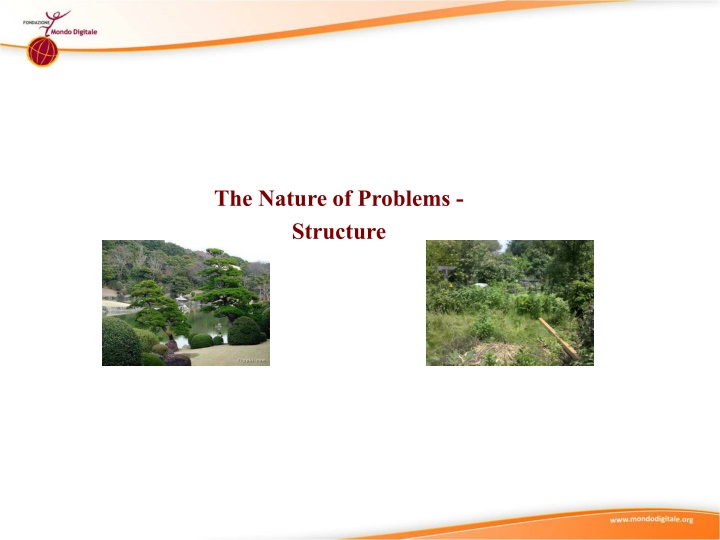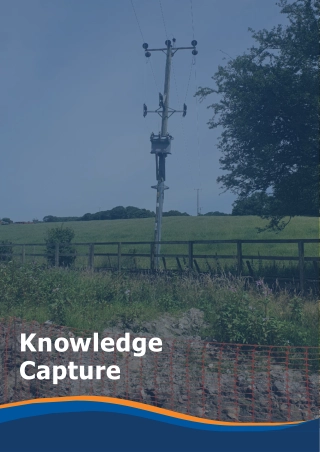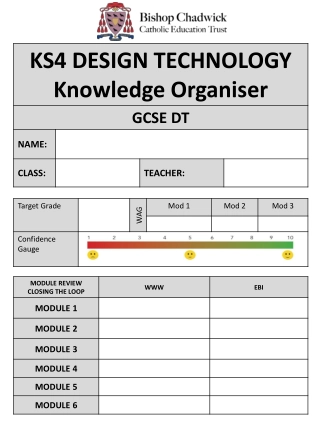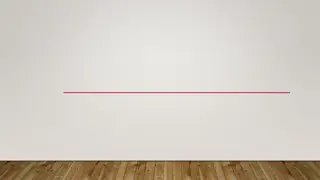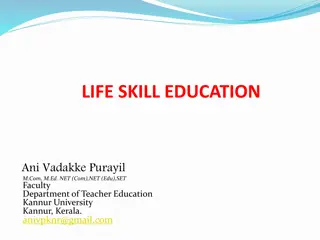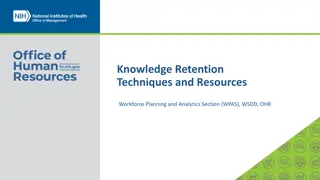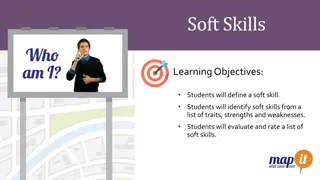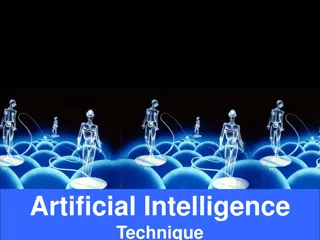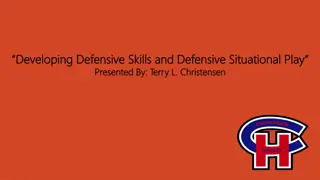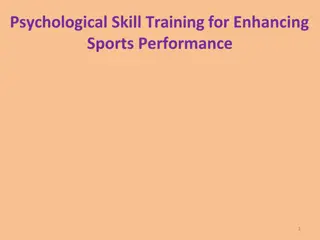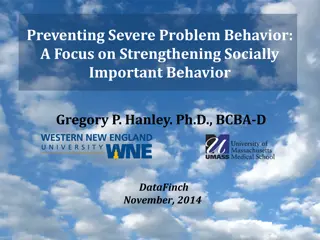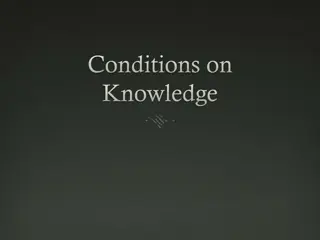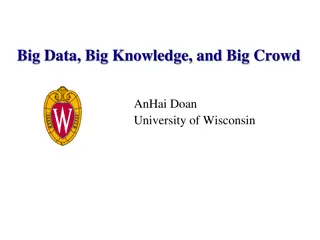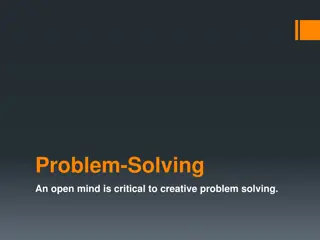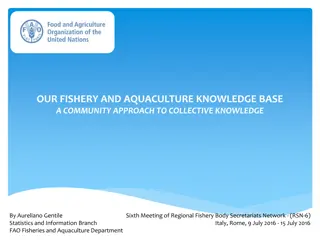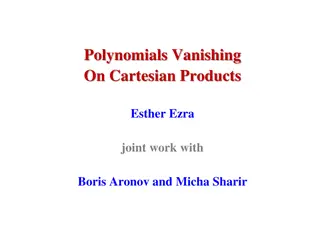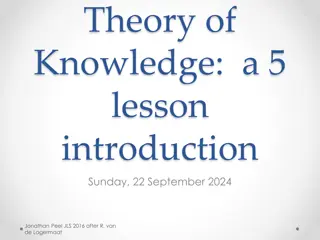Enhancing Knowledge and Skills in Problem Structure
Suggestions for conducting group activities to differentiate between well-structured and ill-structured problems. Utilize micro-modules, discussions, and assessments to deepen understanding and reinforce learning concepts related to problem structure. Encourage active participation and reflection among participants.
Download Presentation

Please find below an Image/Link to download the presentation.
The content on the website is provided AS IS for your information and personal use only. It may not be sold, licensed, or shared on other websites without obtaining consent from the author.If you encounter any issues during the download, it is possible that the publisher has removed the file from their server.
You are allowed to download the files provided on this website for personal or commercial use, subject to the condition that they are used lawfully. All files are the property of their respective owners.
The content on the website is provided AS IS for your information and personal use only. It may not be sold, licensed, or shared on other websites without obtaining consent from the author.
E N D
Presentation Transcript
The Nature of Problems - Structure
Didactic Suggestions (1) These are only suggestions, any group of learners is free to experiment with the use of the micro- module. The types, number and order of use of the elements in the micro-module are open to choice. Depending on the learning strategy adopted, elements can be also eliminated or added. For this purpose, the micro-modules can be copied and modified. Ia) Try to start by connecting with the current state of knowledge and experience of the individual in the group/s. Ask the participants if they can distinguish between the complexity (simple / complex) and the structure (well- structured / ill-structured) of a problem. If so, follow the steps below. If the participants are not able to distinguish the difference, then it is better to use the micro-module. (1) Organize students into group/s of 4 or 5 (2) Ask the participants in the group/s to identify: (a) 2 problems they think are well-structured, and (b) 2 problems they think are ill-structured. (3) Ask them to reflect: Why do they think the first two problems are well-structured and the second two problems are ill-structured? What is it that differentiates them? (4) Ask the the groups to convene and share their results by selecting and presenting 2 well-structured problems and 2 ill-structured problems per group. Then, they present their conclusions regarding Why a problem is well- structured? and Why a problem is ill-structured ?
Didactic Suggestions (3) (IIa) Use the micro-module Nature of the Problems - Structure to reinforce and deepen the understanding of the concept of Structure in Nature of Problems. (1) Introduce the micro-module Nature of Problems - Structure to the participants, explaining its multimedia, multi-dimensional, multi-role, multi-didactic intention. Explain that this is a more complex micro-module made up of several concepts. (2) Ask the participants in the group/s to focus first on the concept of Structure and explore individually the micro-module searching, focusing their attention and reflecting on those elements they find most effective in reinforcing and deepening their understanding of the concept of Structure in the Nature of Problems. (1) The participants tell their groups about their first 3 choices of most effective elements and explain why they have selected them. The participants reflect collectively about their choices and their reasons. If some participants do not find the types of elements most appropriate to them, they can tell about those element and, even better, find them and contribute them to the micro-module.
Didactic Suggestions (4) (IIb) Use the micro-module Nature of Problems - Structure to reinforce and deepen the understanding of the concept of Structure in Nature of Problems. (4) Ask the participants in each group to return to the 2 well-structured and the 2 ill-structured problems they identified in the first part of the activity and assess them individually using the instrument provided in the micro-module. Use one copy of the instrument per problem. The participants compare their individual assessments with those of the other members of the group. They discuss the reasons for the differences and agree on a group assessment, again using one copy of the instrument per problem. (5) The groups convene and share their results, first, by selecting and presenting 3 choices of most effective elements per group, along with their conclusions as to why different people may have different preferences regarding elements and ways of learning; second, by presenting their collective assessment of the structure of their selected problems and the reasons for this assessment. The groups discuss to see whether they arrive to a general agreement or a diversity of opinions prevails. (6) Participants fill in the brief questionnaire about their preferences regarding the elements in the micro-module.
Nature of Problems Structure
Nature of Problems - STRUCTURE The STRUCTURE of a problem is defined by the combination of 5 dimensions: Heterogeneity of Interpretation Transparency Problem Structure Legitimacy of Competing Alternatives Dinamicity Interdisciplinarity
Nature of Problems Problems can vary in STRUCTURE Well-structured Problems Ill-structured Problems Problems Transparency The more we know about the problems (and problem area), the better structured, transparent and easier they are. Heterogeneity of Interpretations The less open to different interpretations is the understanding or solutions of problems, the better structured and easier they are. Dinamicity The greater the stability and continuity of problems, the better structured and easier to comprehend they are. Interdisciplinarity The lower the interdisciplinarity of problems, the better structured and easier to comprehend, they are. Legitimacy of Competing Alternatives The lower the number of conceivable solution paths to problems, the better structured and easier they are.
Nature of Problems Problems can vary in STRUCTURE Well-structured Ill-structured Structuredness WELL-STRUCTURED PROBLEM A problem is well structured when: (a) all necessary knowledge is known (a) it is open to a single interpretation (b) it belongs to a single discipline (c) it does not change with time (stable) (d) it has a single solution path
Nature of Problems Problems can vary in STRUCTURE Well-structured Ill-structured Structuredness ILL-STRUCTURED PROBLEM A problem is ILL-STRUCTURED when: (a) it has many unknown areas (b) it is open to many possible interpretations (c) it involves a large number of disciplines (d) it is highly dynamic (unstable) in time (e) it has a large number of conceivable solution paths
Nature of Problems Problems can vary in the amount of known or unknown knowledge areas Known /Unknown Areas All known Many unknowns
Nature of Problems Problems can vary in the amount of interpretations they can have One interpretation Multiple interpretations Interpretations Maintenance Management Marketing How they Interpreted the Swing Manufacturing Engineering Customer
Nature of Problems Problems can vary in the amount of disciplines involved One discipline Multiple disciplines Interdisciplinarity
Nature of Problems Problems can vary in the amount of dynamicity (stability) they have in time Stable Unstable Dinamicity
Nature of Problems Problems can vary in the amount of solution paths they have Single path Multiple paths Amount of Solution Paths
Nature of Problem Well-Structured / Ill-Structured (Wisdom) INTERPRETATION: Everyone in a complex system has a slightly different interpretation. The more interpretations we gather, the easier it becomes to gain a sense of the whole. Margaret J. Wheatley UNKNOWNS: Prepare for the unknown by studying how others in the past have coped with the unforeseeable and the unpredictable. George S. Patton MULTIPLE PATHS: The future is not some place we are going to, but one we are creating. The paths are not to be found, but made, and the activity of making them, changes both the maker and the destination. John Schaar DYNAMISM: A free society is not calm and eventless place - that is the kind of static, dead society dictators try to create. Free societies are dynamic, noisy, turbulent, and full of radical disagreements. Salman Rushdie INTERDISCIPLINARITY: So much of new knowledge and new applications and ideas come when people from different disciplines combine their expertise or their ways of thinking and looking at problems to discover new solutions, ... If we could begin to do that kind of thing and foster the collective growth in many different fields that we are involved in, I think it would be a lot more fun, as well as a lot more productive. Eric Roberts
POEM related to Multiple Paths to Solutions Roads Go Ever On The Road goes ever on and on Down from the door where it began. Now far ahead the Road has gone, And I must follow, if I can, Pursuing it with weary feet, Until it joins some larger way, Where many paths and errands meet. And whither then? I cannot say. Roads go ever ever on, Over rock and under tree, By caves where never sun has shone, By streams that never find the sea; Over snow by winter sown, And through the merry flowers of June, Over grass and over stone, And under mountains in the moon. The Road goes ever on and on Out from the door where it began. Now far ahead the Road has gone. Let others follow, if they can! Let them a journey new begin. But I at last with weary feet Will turn towards the lighted inn, My evening-rest and sleep to meet. J.R.R. Tolkien (The Lord of the Rings) Roads go ever ever on, Under cloud and under star. Yet feet that wandering have gone Turn at last to home afar. Eyes that fire and sword have seen, And horror in the halls of stone Look at last on meadows green, And trees and hills they long have known. The Road goes ever on and on Down from the door where it began. Now far ahead the Road has gone, And I must follow, if I can, Pursuing it with eager feet, Until it joins some larger way, Where many paths and errands meet.
Nature of Problems Instrument to Assess the STRUCTURE of a Problem
Degree of Problem Structuredness - Well-structured / Ill-structured All known Many unknowns Transparency 1 2 3 4 5 6 7 8 9 10 Single interpretation Many interpretations Heterogeinity of Interpretations 1 2 3 4 5 6 7 8 9 10 Single discipline Many disciplines Interdisciplinarity 1 2 3 4 5 6 7 8 9 10 Stable Highly dynamic Dynamicity 1 2 3 4 5 6 7 8 9 10 Single solution path Many solution paths Competing Alternatives Solutions 1 2 3 4 5 6 7 8 9 10 Total: Ill-structured Well-structured Problem Structure = Total / 5 1 2 3 4 5 6 7 8 9 10
Brief Questionnaire How do you rate the usefulness of the following elements for your learning? Very Low Low Moderate High Very High Definition Wisdom Fun Poetry Assessmen t Instrument What other elements would you like to see in the micro-module?
Acknowledgements Developed by Alfonso Molina Sources Various works by David Jonassen Various Quotation Websites Various Poetry Websites Various websites with images relating to the concept of Problem
